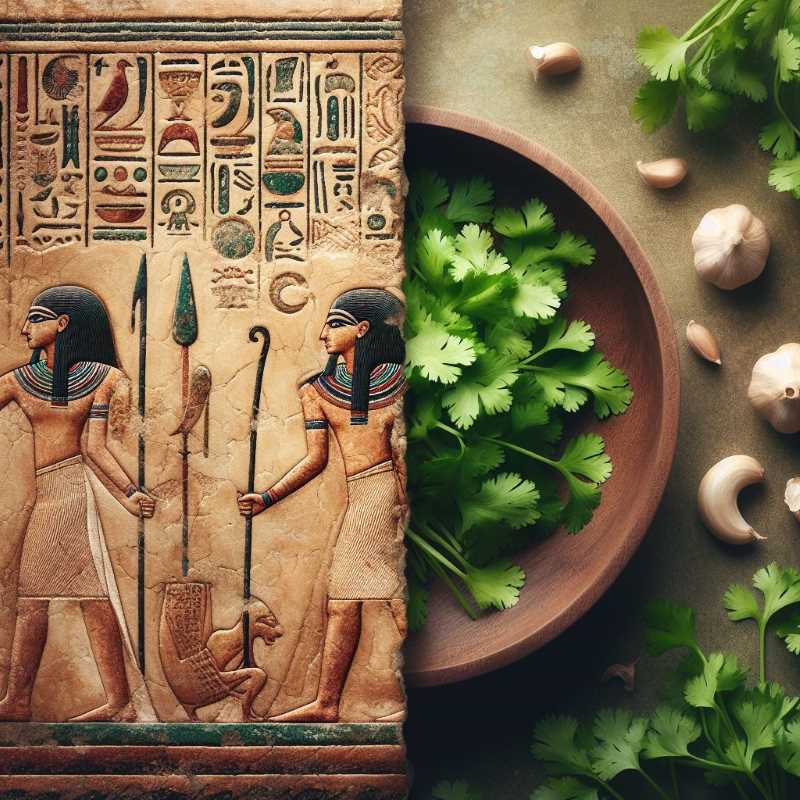Is Cilantro a Love Potion of Soapy Scourge?
Cilantro: Love or hate it, this herb's divisive nature stems from genetics. Despite controversy, it was once revered for enhancing wine and bestowing immortality. Cilantro packs health benefits and a rich history.

Cilantro. It's the Marmite of the herb world, inspiring impassioned declarations of love and equally fervent cries of revulsion. Those who relish its citrusy punch swear it can elevate any dish, while the “soapy gene” sufferers recoil at its mere presence. But before you relegate cilantro to the culinary purgatory of your crisper drawer, dare to reconsider. This humble green leaf boasts a history as rich and vibrant as its flavor.
Imagine ancient Egyptians, decked in gold and linen, spiking their wine with cilantro leaves for a little “herbal enhancement.” Or Roman chefs, toga-clad and gladiator-adjacent, infusing their stews with the seeds of this versatile plant. Cilantro wasn't just a garnish; it was a symbol of everything from wit to immortality (talk about high expectations for your pesto!).
Fast-forward to today, and cilantro is still turning heads (and noses). Scientists have traced some of the “soapy” aversion to a genetic oddity that amplifies certain taste receptors. Basically, your cilantro love (or hate) may be written in your DNA.
Beyond the flavor wars, cilantro packs a serious nutritional punch. It's bursting with anti-inflammatory goodness, cholesterol-lowering potential, and blood sugar-regulating magic. Its essential oils and flavonoids are like tiny ninjas fighting for your health, and it even has a side hustle as a natural digestive aid. So, how do you harness this culinary chameleon?

Cilantro 101: A Beginner's Guide to Green Gold
Fresh cilantro is your gateway to flavortown. Look for bright-green, firm leaves, and remember, this diva wilts faster than a reality TV star on social media. Store it in the fridge, but use it within a few days (unless you're into that wilted, slightly-soapy vibe).
Coriander seeds, on the other hand, are shelf-stable rockstars. Whole seeds can hang out for a year, while their ground counterparts are happy for six months. If your seeds have been chilling for a while, give them a quick cold-water soak to reawaken their slumbering essential oils.
Think beyond guacamole, amigos! Cilantro is a global citizen, at home in Mexican salsas, Portuguese stews, and Thai curries. It adds zing to soups, brightens vegetable dishes, and even elevates that humble bowl of broth to gourmet heights.
And hey, if the “soapy” thing still gets you, there's no shame in skipping it. But for the cilantro converts, embrace your inner herbivore and let this leafy legend work its magic on your taste buds and your health. Remember, life's too short to deny yourself a sprinkle of green gold.
Love it or hate it, there's no denying its fascinating history, impressive health benefits, and undeniable versatility in the kitchen. So go forth, explore, experiment, and remember, a little cilantro can go a long way (unless you have the “soapy gene,” then maybe just a very, very small way).

How to Cook Using Cilantro and Coriander
Cilantro, the fresh, leafy charmer, is like the life of the party – bursting with citrusy, grassy notes that instantly bring any dish to life. But this little green goddess is a delicate diva. Forget dried leaves, they're about as exciting as a cardboard cutout at a disco. No, no, no. Cilantro craves the spotlight, so use it fresh for maximum impact. And don't relegate those stems to the compost bin! They're packed with flavor too, so chop them up and throw them in the party mix.
Coriander, on the other hand, is the brooding, smoldering partner. Its seeds, small and unassuming, hold a deep, earthy warmth that's ready to unleash its magic with a little coaxing. To unlock their full potential, toast them in a dry pan over low heat until they sizzle and release their intoxicating aroma. Think of it as waking up a sleepy dragon – its fiery essence will fill your kitchen with the promise of exotic adventures.
Grinding these little flavor bombs is optional, but it's like giving them a microphone. A quick whirl in a spice mill or coffee grinder (or a vigorous workout with a mortar and pestle, if you're feeling primal) will amplify their voice and spread their warmth throughout your dish.
Now, remember, cilantro is all about freshness, so add it near the end of cooking to preserve its vibrant color and delicate touch. Coriander, on the other hand, is happy to simmer away, infusing its deep warmth into long-cooked stews and curries.
Cilantro and coriander: the yin and yang of the flavor world, ready to make your meals sing. Experiment, have fun, and don't be afraid to let these two take center stage. Remember, with a little love and attention, they'll transform your cooking from a humdrum routine to a full-blown flavor fiesta. And, if you are feeling adventurous, muddle some cilantro leaves in your next margarita for a citrusy twist. Just don't blame me if you end up dancing on the table.




